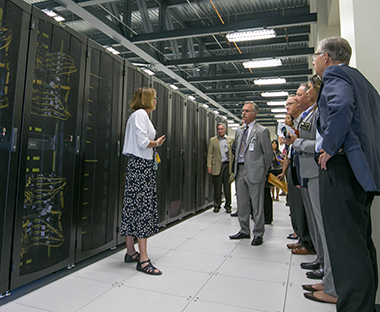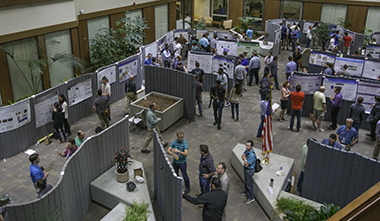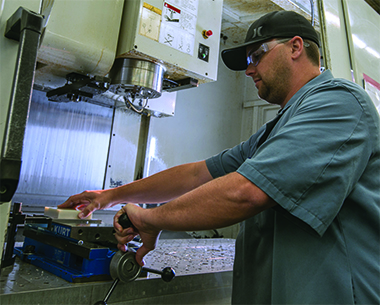Positioning the Laboratory for continuing science and technology excellence directed at important national missions
In FY 2016, LLNL focused on engaging with sponsors and stakeholders, strategic planning, and building for future successes.
Strategic Engagements and Planning
Director Bill Goldstein and his management team participated in discussions about national security and the evolving strategic landscape with wide-ranging audiences. Events in Washington, D.C., early in the fiscal year included National Security Lab Day on Capitol Hill, NNSA’s 20th Anniversary of Stockpile Stewardship event, and the Strategic Weapons in the 21st Century Conference, co-hosted by LLNL and LANL. Livermore also participated in DOE’s Big Ideas Summits, organized and hosted the U.S. Air Force Nuclear Enterprise Meeting in January 2016, provided the venue for Apex Gold (see Apex Gold ), and staged workshops on cross-domain deterrence. These engagements helped provide a foundation for strategic planning activities.
The strategic planning effort provided a fresh re-examination of the Laboratory’s programmatic, workforce, and infrastructure directions. Working groups drawn from across the Laboratory focused on four programmatic directions—modern deterrence, cyber security, biosecurity, resource security, and two cross-cutting issues—workforce and infrastructure. Key mission research challenges were identified, which together with the Laboratory’s set of core competencies, will provide direction for internal investment priorities in science, technology, and engineering (ST&E). Initiatives are under way to ensure continued workforce excellence and to modernize the Laboratory’s facilities and infrastructure (F&I).
Investing in Facilities and Infrastructure
Officials from NNSA and other government representatives visited in June to dedicate a new supercomputing facility at the Laboratory. The $9.8 million sustainable facility provides flexibility to accommodate future advances in computer technology and meet a rapidly growing demand for unclassified high-performance computing. The facility is now home to a Sierra “early delivery” system and the first of NNSA’s next-generation-capacity computing machines (see Preparing for Sierra and Beyond ).
Additional construction is under way supported by increased direct funding from NNSA. LLNL will be executing nearly $100 million of construction projects in FY 2017–2018. A new line item–funded project—the first since 2009—will expand the Laboratory’s electrical utility distribution system. Other projects range from upgrades to radiochemistry laboratories to new safety systems at Site 300.
Future F&I plans were reviewed at NNSA’s first Master Asset Plan “Deep Dive” meeting, held at LLNL. Livermore is working as an innovative partner with NNSA to develop methodologies, templates, and tools for the enterprise-wide Master Asset Plan. The objective is to achieve prioritized, long-term enterprise planning that reduces risk and aligns infrastructure investments with mission goals. Three LLNL teams received NNSA Office of Safety, Infrastructure, and Operations Excellence Awards for their F&I efforts. One team is implementing BUILDER, a knowledge-based condition assessment infrastructure modeling system, and another is refining the Mission Dependency Index, a tool for assessing the mission consequences of F&I failure. The third team manages legacy facilities at the lowest cost while mitigating risks to workers and the public.
NNSA also selected LLNL as the lead for the complex-wide Cooling and Heating Asset Management Program (CHAMP) partnership. Based on a unique groundbreaking approach to supply chain management pioneered at Livermore, CHAMP is NNSA’s first-ever building system-based program for strategically managing inherently complex heating and cooling infrastructure.
Sustaining Workforce Excellence
An outstanding workforce is the Laboratory’s principal strength. Staff members bring to their jobs impactful new ideas, work with integrity and zeal, and thrive in an inclusive work environment. LLNL was named to the Forbes 2016 list of America’s Best Employers, ranking No. 102 out of the 500 employers chosen. It was the only national laboratory on the list and ranks among the top 10 employers in the San Francisco Bay Area. Accomplishments and initiatives highlight staff quality and the importance of recruiting and nurturing future technical and programmatic leaders. Notably, 19 Laboratory employees received DOE Secretary’s Honor Awards this year and another was given the Office of Secretary of Defense Medal for Exceptional Public Service (see Workforce Recognition ).
Livermore’s educational outreach programs range from activities designed to interest young students in scientific careers (see Community Connections ) to those that bring prospective future scientists and engineers to LLNL. In FY 2016, the Laboratory welcomed more than 900 students—a new record—with many coming as interns during the summer academic break. In addition, LLNL continues to expand the hiring of postdoctoral fellows. About 220 fellows are onsite and the conversion rate from postdoctoral fellow to staff member is about 65 percent. LLNL is also establishing strategic partnerships with strong research universities to keep at the cutting-edge of ST&E. Furthermore, the Laboratory is pursuing initiatives to meet mission needs for engineering support, including a machinist apprentice program and a veterans training program.
LLNS Board of Governors Activities
The LLNS Board of Governors and its committees provided oversight to the Laboratory. The committees delved into issues crucial to mission and mission-support activities. Board members participated in external review committees (ERCs)—panels of independent experts—to critically assess the quality of LLNL’s technical workforce and the effectiveness of research efforts in meeting mission goals and anticipating future national needs. The ERCs held six meetings in FY 2016. Their reports, which provided DOE/NNSA with an independent validation of work quality, consistently affirmed the mission relevance and high impact of Laboratory research. The Board also charters Functional Management Reviews (FMRs) to examine issues on an as-needed basis. Six FMRs were completed in FY 2016 in topical areas ranging from banking and payment processing to work planning and control. Recommendations provided by Board committees, ERCs, and FMRs have led to substantive responsive actions.









